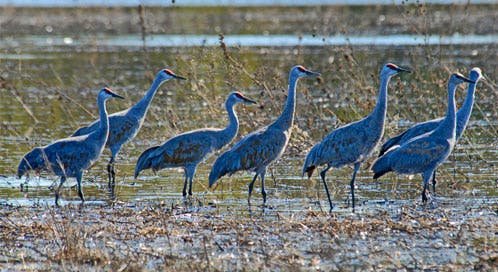With three consecutive years of extremely dry weather, California is going through the worst water crisis in the state’s modern history. The drought’s impacts on vulnerable fish and wildlife have been profound—low levels of water have devastated salmon runs, increased disease outbreaks among migrating birds, worsened the condition of other native wildlife, and contributed to an outbreak of potentially toxic blue-green algae in the Delta.
Faced with this ongoing emergency, Governor Brown and the California legislature have sprung into action, taking concrete steps towards a more sustainable water future. Among other actions, Governor Brown has convened an Interagency Drought Task Force, declared a State of Emergency, and issued a Water Action Plan that outlines solutions for both short-term and long-term relief. The legislature passed historic legislation to improve how the state monitors and manages critically important groundwater basins. They also showed broad, bipartisan support for a $7.5 billion water bond that California’s voters approved on November 4.

The drought is so severe that many of California’s riverbeds are completely dry. (Photo: NOAA)
The state’s leadership has created indispensable momentum, but we still need guidance on specific policies that legislators, agency officials, and local decision makers can begin implementing immediately. Recognizing this need, Defenders of Wildlife teamed up with several other environmental organizations to create a plan of action—titled Wetter or Not – Actions to Ease the Current Drought and Prepare for the Next—that was released November 17, 2014. The report recommends specific, short-term actions at the state, federal, and local levels that will respond to the drought while also setting the stage for a more reliable long-term water supply, a more resilient economy, and a healthier environment. We especially focused on:
- Stretching existing supplies by making urban and agricultural water use more efficient, encouraging water recycling, and improving stormwater capture;
- Expanding the system’s storage capacity by protecting our groundwater, investing in natural infrastructure, and restoring watersheds;
- Planning for this and future droughts, with a focus on protecting salmon and wetland-dependent species; and
- Securing funding at the state, federal, and local levels to make sure managers have what they need to put these solutions into practice.
Smart water planning is good for communities and good for wildlife. For example, restoring healthy watersheds in forests and meadows can improve both water quality and availability, while also creating habitat for animals like the endangered riparian brush rabbit, and improving stream temperatures for migrating salmon. Careful drought planning can help make sure there’s enough water to deliver to farmers, and also to wildlife refuges that provide habitat for long-billed curlews, greater sandhill cranes, and other imperiled birds.
Over the coming months and years, we will work with local, state, and federal officials to encourage them to put the report’s recommendations into action. Even if this winter brings much needed rain to the parched state, California will continue to suffer from droughts, and a plan of action is essential to a future that includes both a healthy economy and thriving wildlife and ecosystems.
Rachel Zwillinger is the Water Policy Advisor at Defenders of Wildlife
From the Blog






Follow Defenders of Wildlife
facebook twitter instagram youtube tiktok threads